
A group of actors declaim excerpts from Mallarmé's "A Throw of the Dice Will Never Abolish Chance" in the cemetery where the martyrs of the Paris Commune were shot in 1871.
EN
“1: A pan. Bare tree crowns against the blinding light of spring, birds chirping, static noise. Next. The camera tilts from the sky over an apartment building and ends by a stone wall where bouquets of red and white roses lie scattered on the ground. These words are written on a memorial tablet: AUX MORTS DE LA COMMUNE 21-28 MAI 1871. This wall, also known as Le mur des fédérés, marks the threshold between the city and the cemetery, whose earth became a battlefield and mass grave for the communards during the Paris Commune's brutal dissolution.
Cut. After the opening quote by Jules Michelet, "Every revolution is a throw of dice," nine young people are seen sitting like motionless talking stones in the grass, reciting Stéphane Mallarmé's poem "A Throw of the Dice Will Never Abolish Chance" (1897). Apart from the first shot, the speech act resists eye contact with the camera. The film is edited and read aloud according to the typographical variations that Mallarmé used when writing the poem. It is Huillet's film; it is her voice and gestures that, backed by the strength of the collective, mediate the poem from another time to "the gesture of a spectre that will wobble and crash."
2: From this, you could be prompted to think that H/S bring forth a historical theme of the commune's dissolution. A dissolution that, for a significant part, was caused by the way the communards carelessly distributed images of liberation, which featured themselves in front of the barricades on the boulevardized streets. These photographs ended up in the hands of the police and became the informers of the commune: For the first time in history, the police could use photographs as evidence and persecution by linking identity, name, and photography. This historical event helped form H/S's pictorial politics of resistance. Just as an image only exists because of a previous image, in the eyes of H/S, history is always already at our feet.
3: In 1977, it was a historical and political provocation to lament the communards of 1871 when another, far more current communist tragedy had occurred in the streets of Paris on February 8, 1962, at the end of the Algerian War. The war that all cast members had refused to participate in, which is why they only returned to France from exile in the mid-1970s. The French Communist Party had arranged an urgent peace demonstration for the independence of Algeria only a few hours after colonialist, far-right and paramilitary resistance group OAS bombed the home of the then Minister of Culture André Malraux. The only harm they managed to cause was to blind one eye of a four-year-old girl, Delphine Renard. The demonstration was a call for urgent duty of resistance but was also a violation of the curfew, which at the time applied to all Algerians, French-Algerian workers, and Muslims. The curfew prohibited them from leaving their home after half past eight in the evening. During the chaos and breaking-up of the demonstration, which would later, but not until much later, be referred to as The Charonne Massacre, nine pro-Algerian protesters from the French Communist Party were murdered by the Parisian police on the steps of the Charonne metro station under the guidance of the police prefect Maurice Papon. Papon's police broke up the demonstration before it had even started on Place de Bastille, causing the protesters to take flight down the boulevards near Père Lachaise Cemetery. It is said that the Parisian police officers tore the iron railings off the plane trees and threw them down on the protestors, who, to get away, were trapped in droves on the metro steps. Unlike the 1961 Paris massacre, the trains never stopped running.
4: As Straub says – after quoting a long passage from Jean Jacques Rousseau's preface to Discourse on the Origin and Basis of Inequality Among Men (1755) – in his short film Joachim Gatti, variation de lumière (2009), which is about Gatti, who lost an eye when police fired on a group of protesters in Montreuil July 8, 2009: "And now I, Straub, say that it is the police – armed by capital – it is them, who kill."
Nothing is left to chance in the films of Huillet and Straub. When something is shown, something else is hidden.”
Frederik Tøt Godsk1

